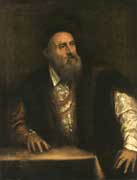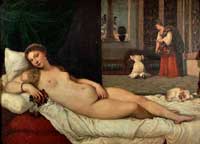Tiziano Vecellio was born in Pieve of Cadore in 1490. He was very young when he moved to Venice to be apprenticed in the workshop of Sebastiano Zuccato and then in the workshop of Gentile and Giovanni Bellini. Giorgione greatly influenced the style of his art and the two artists, between 1508 and 1509, painted the frescos for the facades of the Fondaco dei Tedeschi in Venice (they have perished). In 1510 Titian received a commission for two altarpieces: the Altar piece of St Mark and the Altar piece of Santa Maria della Salute. In 1511, in Padua, he painted the frescos in the School of the Saint.
Bellini. Giorgione greatly influenced the style of his art and the two artists, between 1508 and 1509, painted the frescos for the facades of the Fondaco dei Tedeschi in Venice (they have perished). In 1510 Titian received a commission for two altarpieces: the Altar piece of St Mark and the Altar piece of Santa Maria della Salute. In 1511, in Padua, he painted the frescos in the School of the Saint.
In 1513 he was invited to Rome by Pope Leo X, but he preferred to stay in Venice where he became the official painter of the Serenissima after the death of Giovanni Bellini.
In this period he painted many pictures with secular subjects for Venetian noblemen including: Concert in a Field (Louvre), the Adulteress (Glasgow), and Holy and secular Love (Borghese Gallery of Rome). Masterpieces of this period are the Assunta in Santa Maria Gloriosa dei Frari in Venice (1518) and the altar piece Pesaro sempre per i Frari painted between 1519 and 1526.
In 1518 Titian started working for Alfonso I d’Este, who commissioned the painting of the “alabaster studiolo”, and three canvases with mythological subjects: the Festival of Venus, Bacchanals (Prado Museum) and Bacchus and Ariadne (London National Gallery). The most important rulers of Italy wanted their portraits painted by Titian and he was invited to many courts. He worked for the Gonzaga family in Mantua and for the dukes of Urbino. In his paintings he managed to portray the character of the  sitters as well as their looks, turning portraits into masterpieces, like the portraits of Federico Gonzaga, of Cardinal Ippolito dei Medici, of Francesco della Rovere, of Francesco I and of Carlo V.
sitters as well as their looks, turning portraits into masterpieces, like the portraits of Federico Gonzaga, of Cardinal Ippolito dei Medici, of Francesco della Rovere, of Francesco I and of Carlo V.
The natural look of his portraits comes out in paintings of holy subjects as well, such as the presentation of Mary at the Temple, and in pictures of secular subjects, like the Venus of Urbino, which represent the beauty ideal of XVI century naturalist style.
After painting all these pictures the style of his art changed. In the Crown of Thorns, in the church of Santa Maria delle Grazie in Milan, plastic and formal elements are more important than colours.
A good example of the last phase of Titian’s painting is Death of St. Peter Martyr, where his painting style has changed and light and colour are the main elements. Paintings from this period include: Annunciation, Crucifixion and Pietà (which was never finished).
Titian died in Venice, during the plague, on 27th August 1576 and was buried in the church of Santa Maria Gloriosa dei Frari.
Lomazzo, Idea del tempio della pittura, 1590
Ma fra tutti risplende come sole fra piccole stelle Tiziano, non solo fra gli italiani, ma fra tutti i pittori del mondo, tanto nelle figure quanto nei paesi, aguagliandosi ad Apelle, il quale fu il primo inventore dei tuoni, delle piogge, dei venti, del sole, dei folgori e delle tempeste. E spezialmente esso Tiziano ha colorito con vaghissima maniera i monti, i piani, gli arbori, i boschi, le ombre, le luci e le inondazioni del mare e dei fiumi, i terremoti, i sassi, gli animali e tutto il resto che appartiene ai paesi. E nelle carni ha avuto tanta venustà e grazia, con quelle sue mischie e tinte, che paiono vere e vive, e principalmente le grassezze e le tenerezze che naturalmente in lui si vedono. La medesima felicità ha dimostro nel dar i colori ai panni di seta, di velluto e di broccato, alle corazze diverse, agli scudi e ai giacchi e ad altre simili cose.